SS Great Eastern
SS Great Eastern was an iron sailing steamship designed by Isambard Kingdom Brunel, and built by J. Scott Russell & Co. at Millwall Iron Works on the River Thames, London. She was by far the largest ship ever built at the time of her 1858 launch, and had the capacity to carry 4,000 passengers from England to Australia without refuelling. Her length of 692 feet (211 m) was only surpassed in 1899 by the 705-foot (215 m) 17,274-gross-ton RMS Oceanic, her gross tonnage of 18,915 was only surpassed in 1901 by the 701-foot (214 m) 21,035-gross-ton RMS Celtic, and her 4,000-passenger capacity was surpassed in 1913 by the 4,935-passenger SS Imperator. The ship's five funnels were rare and were later reduced to four. It also had the largest set of paddle wheels.
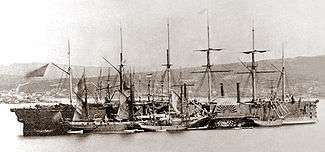 Great Eastern at Heart's Content, July 1866 | |
| History | |
|---|---|
| Name: | Great Eastern |
| Port of registry: | Liverpool |
| Ordered: | 1853 |
| Builder: | J. Scott Russell & Co., Millwall |
| Laid down: | 1 May 1854 |
| Launched: | 31 January 1858 |
| Completed: | 1859 |
| Maiden voyage: | 30 August 1859 |
| In service: | 1859 |
| Out of service: | 1889 |
| Struck: | 1889 |
| Homeport: | Liverpool |
| Nickname(s): | The great ship |
| Fate: | Scrapped 1889–90 |
| Status: | Scrapped |
| Notes: |
Struck rocks on 27 August 1862 Was the largest ship for four decades |
| General characteristics | |
| Type: | Passenger ship |
| Tonnage: | 18,915 grt[1] |
| Displacement: | 32,160 tons |
| Length: | 692 ft (211 m) |
| Beam: | 82 ft (25 m) |
| Decks: | 4 decks |
| Propulsion: | Four steam engines for the paddles and an additional engine for the propeller. Total power was estimated at 8,000 hp (6.0 MW). Rectangular boilers[2] |
| Speed: | 14 knots (26 km/h)[3] |
| Boats & landing craft carried: | 18 lifeboats; after 1860 20 lifeboats |
| Capacity: | 4,000 passengers |
| Complement: | 418 |
Brunel knew her affectionately as the "Great Babe". He died in 1859 shortly after her maiden voyage, during which she was damaged by an explosion. After repairs, she plied for several years as a passenger liner between Britain and North America before being converted to a cable-laying ship and laying the first lasting transatlantic telegraph cable in 1866.[4] Finishing her life as a floating music hall and advertising hoarding (for the department store Lewis's) in Liverpool, she was broken up on Merseyside in 1889.
History
Concept
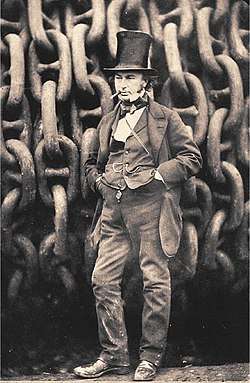
After his success in pioneering steam travel to North America with Great Western and Great Britain, Brunel turned his attention to longer voyages as far as Australia and realised the potential of a ship that could travel round the world without the need of refuelling.[5]
On 25 March 1852, Brunel made a sketch of a steamship in his diary and wrote beneath it: "Say 600 ft x 65 ft x 30 ft" (180 m x 20 m x 9.1 m). These measurements were six times larger by volume than any ship afloat; such a large vessel would benefit from economies of scale and would be both fast and economical, requiring fewer crew than the equivalent tonnage made up of smaller ships. Brunel realised that the ship would need more than one propulsion system; since twin screws were still very much experimental, he settled on a combination of a single screw and paddle wheels, with auxiliary sail power. Although Brunel had pioneered the screw propeller on a large scale with the Great Britain, he did not believe that it was possible to build a single propeller and shaft (or, for that matter, a paddleshaft) that could transmit the required horsepower to drive his giant ship at the required speed.[6]
Brunel showed his idea to John Scott Russell, an experienced naval architect and ship builder whom he had first met at the Great Exhibition. Scott Russell examined Brunel's plan and made his own calculations as to the ship's feasibility. He calculated that it would have a displacement of 20,000 tons and would require 8,500 horsepower (6,300 kW) to achieve 14 knots (26 km/h), but believed it was possible. At Scott Russell's suggestion, they approached the directors of the Eastern Steam Navigation Company.
Eastern Steam Navigation Company
The Eastern Company was formed in January 1851 with the plan of exploiting the increase in trade and emigration to India, China and Australia. To make this plan viable they needed a subsidy in the form of a mail contract from the British General Post Office, which they tendered for and Brunel started the construction of two vessels, Victoria and Adelaide. However, in March 1852 the Government awarded the contracts to the Peninsular and Oriental Steam Navigation Company, even though the Eastern Company's tender was lower. This left them in the position of having a company without a purpose.
Brunel's large ship promised to be able to compete with the fast clippers that currently dominated the route, as she would be able to carry sufficient coal for a non-stop passage and the company invited him to present his ideas to the board. He was unable to attend due to illness and Scott Russell took his place.
The Company then set up a committee to investigate the proposal, and they reported in favour and the scheme was adopted at a board meeting held in July 1852. Brunel was appointed Engineer to the project and he began to gather tenders to build the hull, paddle engines and screw engines. Brunel had a considerable stake in the company and when requested to appoint a resident engineer refused in no uncertain terms:
I cannot act under any supervision, or form part of any system which recognises any other advisor than myself ... if any doubt ever arises on these points I must cease to be responsible and cease to act.
He was just as firm in the terms for the final contract where he insisted that nothing was to be undertaken without his express consent, and that procedures and requirements for the construction were specifically laid down.
1854–1859: Construction to maiden voyage
Construction
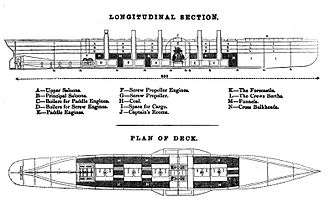
.jpg)
Although Brunel had estimated the cost of building the ship at £500,000, Scott Russell offered a very low tender of £377,200: £275,200 for the hull, £60,000 for the screw engines and boilers, and £42,000 for the paddle engines and boilers. Scott Russell even offered to reduce the tender to £258,000 if an order for a sister ship was placed at the same time. Brunel accepted Scott Russell's tender in May 1853, without questioning it; Scott Russell was a highly skilled shipbuilder and Brunel would accept an estimate from such an esteemed colleague without question.[7]
In early 1854 work could at last begin. The first problem to arise was where the ship was to be built. Scott Russell's contract stipulated that it was to be built in a dock, but Russell quoted a price of £8,000–£10,000 to build the necessary dock and so this part of the scheme was abandoned, partly due to the cost and also to the difficulty of finding a suitable site for the dock. The idea of a normal stern first launch was also rejected because of the great length of the vessel, also because to provide the right launch angle the bow of the ship would have to be raised 40 feet (12 m) in the air. Eventually it was decided to build the ship sideways to the river and use a mechanical slip designed by Brunel for the launch. Later the mechanical design was dropped on the grounds of cost, although the sideways plan remained.
Having decided on a sideways launch, a suitable site had to be found, as Scott Russell's Millwall, London, yard was too small. The adjacent yard belonging to David Napier was empty, available and suitable, so it was leased and a railway line constructed between the two yards for moving materials. The site of the launch is still visible on the Isle of Dogs. Part of the slipway has been preserved on the waterfront, while at low tide, more of the slipway can be seen on the Thames foreshore. The remains of the slipways, and other structures associated with the launch of the SS Great Eastern, have recently been surveyed by the Thames Discovery Programme, a community project recording the archaeology of the Thames intertidal zone in London.
Great Eastern's keel was laid down on 1 May 1854. The hull was an all-iron construction, a double hull of 19 mm (0.75 in) wrought iron in 0.86 metres (2 feet 10 inches) plates with ribs every 1.8 m (5.9 ft). Internally, the hull was divided by two 107 m (351 ft) long, 18 m (59 ft) high, longitudinal bulkheads and further transverse bulkheads dividing the ship into nineteen compartments. Great Eastern was the first ship to incorporate the double-skinned hull, a feature which would not be seen again in a ship for several decades, but which is now compulsory for reasons of safety.
She had sail, paddle and screw propulsion. The paddle-wheels were 17 m (56 ft) in diameter and the four-bladed screw-propeller was 7.3 m (24 ft) across. The power came from four steam engines for the paddles and an additional engine for the propeller. Total power was estimated at 6 MW (8,000 hp). The specific requirements of the Eastern Company also vindicated Brunel's initial concept of using both paddlewheels and a screw. The Great Britain had a chain drive 'overdrive' gear so that the slow-turning marine steam engines of the day could drive a screw propeller of a suitably small diameter while making the required thrust. This had proven troublesome and in his new ship Brunel resolved to use direct drive, requiring the much larger propeller.[8] To be effective this had to be fully submerged at all times, fixing the ship's minimum practical draught while using screw propulsion at around 7.62 m (25.0 ft). Brunel designed the Great Eastern to have a maximum draught of 9.144 m (30.00 ft). The Company required that the ship be able to dock at Calcutta, where navigation was restricted by the shallow Hooghly River which required a draught of no more than 7.0 m (23.0 ft). Brunel calculated that the ship would be able to carry enough coal to steam from Calcutta to a British port while not exceeding that draught, while if the ship took on coal for the final leg of her homeward voyage at Trincomalee instead she would be able to transit the Hooghly with a full load of passengers and cargo while drawing 6.09 m (20.0 ft). This would leave around half of the top-most blade of the screw clear of the water, greatly reducing the thrust it developed and the efficiency of the engines. Thus when operating at lighter loads and shallow draughts, the Great Eastern would require paddlewheels. After consultation with Joshua Field, Brunel set the power of the two sets of engines so that the Great Eastern's paddlewheels provided about a third of the total mechanical propulsion, with the screw propeller providing the majority.[9]
She also had six masts (said to be named after the days of a week – Monday being the fore mast and Saturday the spanker mast), providing space for 1,686 square metres (18,150 sq ft) of sails (7 gaff and max. 9 (usually 4) square sails), rigged similar to a topsail schooner with a main gaff sail (fore-and-aft sail) on each mast, one "jib" on the fore mast and three square sails on masts no. 2 and no. 3 (Tuesday & Wednesday); for a time mast no. 4 was also fitted with three yards. In later years, some of the yards were removed. Her maximum speed was 24 km/h (13 knots).
Scott Russell bankruptcy
At the beginning of February 1856, Brunel advised the Eastern Company that they should take possession of the ship to avoid it being seized by Scott Russell's creditors. This caused Scott Russell's bankers to refuse to honour his cheques and foreclose on his assets and on 4 February Scott Russell suspended all payments to his creditors and dismissed all his workmen a week later.
Russell's creditors met on 12 February and it was revealed that Russell had liabilities of £122,940 and assets of £100,353. It was decided that his existing contracts would be allowed to be completed and the business would be liquidated. He issued a statement to the Board of the Eastern Company in which he repudiated his contract and effectively handed the uncompleted ship back to them. When the situation was reviewed it was found that three-quarters of the work on the hull had not been completed and that there was a deficit of 1,200 tons between the amount of iron supplied and that used on the ship.
Brunel, meanwhile, wrote to John Yates and instructed him to negotiate with Scott Russell for the lease of his yard and equipment. Yates replied that Scott Russell had mortgaged the yard to his banker and that any negotiation would have to be with the bank, who after weeks of wrangling agreed to lease the yard and equipment until 12 August 1857.
The Eastern Company began the task of completing the ship. Work recommenced in May and took longer than expected to complete. Brunel reported in June 1857 that once the screw, screw shaft and sternpost had been installed the ship would be ready for launching. However, the launch ways and cradles would not be ready in time since the contract for their construction had only been placed in January 1857. Under pressure from all sides, the lease of the shipyard costing £1,000 a month, and against his better judgement, Brunel agreed to launch the ship on 3 November 1857 to catch the high tide.
Launch

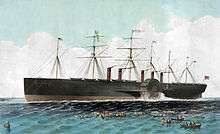
Brunel had hoped to conduct the launch with a minimum of publicity but many thousands of spectators had heard of it and occupied vantage points all round the yard. He was also dismayed to discover that the Eastern Company's directors had sold 3,000 tickets for spectators to enter the shipyard.
As he was preparing for the launch, some of the directors joined him on the rostrum with a list of names for the ship. On being asked which he preferred, Brunel replied "Call her Tom Thumb if you like". At 12:30 pm Henrietta (daughter of a major fundraiser for the ship, Henry Thomas Hope) christened the ship Leviathan much to everyone's surprise since she was commonly known as Great Eastern; her name subsequently changed back to Great Eastern in July 1858.
The launch, was however,[10] unsuccessful as the steam winches and manual capstans used to haul the ship towards the water were not up to the job. Brunel made another attempt on the 19th and again on the 28th, this time using hydraulic rams to move the ship, but these too proved inadequate. The ship was successfully launched sideways at 1:42pm on 31 January 1858, aided by an unusually high tide and strong winds and using more powerful hydraulic rams supplied by the then-new Tangye company of Birmingham, the association with such a famous project giving a useful fillip to the fledgling company.[11]
She was 211 m (692 ft) long, 25 m (82 ft) wide, with a draught of 6.1 m (20 ft) unloaded and 9.1 m (30 ft) fully laden, and displaced 32,000 tons fully loaded. In comparison, SS Persia, launched in 1856, was 119 m (390 ft) long with a 14 m (46 ft) beam.
The site of launch is still partly visible these days next to Burrell's Wharf on the Isle of Dogs.[12]
Suez Canal concerns
In 1857, during the planning of the Suez Canal, it was thought that Great Eastern would not be able to traverse it, since she had a draught of 28 ft (8.5 m) and it was expected that the canal would be excavated to a depth of 26 ft (7.9 m).[13] In any event, when the canal was opened to shipping in 1869, Great Eastern was no longer in passenger service.
Fitting out
The launch of the ship cost £170,000, a third of Brunel's estimate for the entire vessel, and it had yet to be fitted out. It was difficult to get any more money from the Eastern Company's investors as the company was close to bankruptcy. To prevent this from happening, a new company was formed, the "Great Ship Company", with capital of £340,000. They bought the ship for £160,000, which left enough funds for fitting her out. The Eastern Company's shareholders were given the market value of their £20 shares (£2 10s) towards payment for shares in the new company and the Eastern Steam Navigation Company entered liquidation.
Tenders were invited for fitting the ship out, and two were received – one from Wigram and Lucas for £142,000, and the other from John Scott Russell for £125,000. Brunel had taken a long holiday on medical advice and was absent when the contract was awarded to Scott Russell. The work was begun in January 1859, and was completed by August.
Maiden voyage
30 August 1859 was given as the date of the first voyage, but this was later put back to 6 September. The destination was Weymouth, from which a trial trip into the Atlantic would be made. Following this the ship would sail to Holyhead, Wales. The company had made an agreement with the Canada's Grand Trunk Railway to use Portland, Maine as its US destination, and the railway company had built a special jetty to accommodate the ship. William Harrison was appointed Captain in 1856; he drowned on 21 January 1860 while sailing from Hythe to Southampton in the ship's boat.[14]
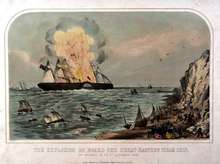
On 9 September the ship had passed down the Thames, and out into the English Channel, and had just passed Hastings when there was a huge explosion, the forward deck blowing apart with enough force to throw the No. 1 funnel into the air, followed by a rush of escaping steam. Scott Russell and two engineers went below and ordered the steam to be blown off and the engine speed reduced. Five stokers died from being scalded by hot steam, while four or five others were badly injured and one had leapt overboard and had been lost. The accident was discovered to have been caused by a feedwater heater's steam exhaust having been closed, and the explosion's power had been concentrated by the ship's strong bulkheads.[15]
1860–1863: Transatlantic voyages
Although designed to carry emigrants on the far Eastern run, the only passenger voyages Great Eastern made were in the Atlantic. Angus Buchanan, an historian of technology comments: "She was designed for the Far Eastern trade, but there was never sufficient traffic to put her into this. Instead, she was used in the transatlantic business, where she could not compete in speed and performance with similar vessels already in service."[16]
First voyage to North America
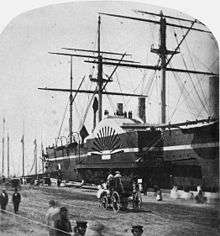
Her first voyage to North America began on 17 June 1860, with 35 paying passengers, eight company "dead heads" (non-paying passengers), and 418 crew. Among the passengers were the two journalists and engineers Zerah Colburn and Alexander Lyman Holley as well as three directors of the Great Ship Company.
Preparations were initially made for the ship to sail on 16 June 1860 and the passengers boarded her on the 14th. After visitors had been sent ashore the Captain (Capt. John Vine Hall) announced that he would not be sailing until the 17th, as the crew were drunk. Director Daniel Gooch, who was travelling aboard her, was not pleased. He was further displeased by the route taken by the ship which was the more southerly of the regular steamer routes as he had wanted the ship to complete the journey in nine days. In the event, the voyage took 10 days 19 hours.
1861 government charter
Upon Great Eastern's return to England, the ship was chartered by the British Government to transport troops to Québec. 2,144 officers and men, 473 women and children, and 200 horses were embarked at Liverpool along with 40 paying passengers. The ship sailed on 25 June 1861 and went at full speed throughout most of the trip arriving at her destination 8 days and 6 hours after leaving Liverpool. Great Eastern stayed for a month and returned to Britain at the beginning of July with 357 paying passengers.[17]
Although the ship had made around £14,000 on its first Atlantic voyage, the Great Ship Company's finances were in a poor state, with their shares dropping in price. They were also threatened with a lawsuit by the Grand Trunk Railway for not making Portland, Maine the ship's port of call as agreed.[18] In addition, Scott Russell had been awarded the sum of £18,000 for repairs following the 1859 explosion. The Company managed to appeal against this but Scott Russell applied to the courts and the Chief Justice found in his favour. The company appealed again, and due to rumours that the ship was about to leave the country, Russell's solicitors took possession of her. The Great Ship Company lost its appeal and had to pay the sum awarded; to cover this and the expenses of a second US voyage, they raised £35,000 using debentures.[19]
Second voyage to North America
Only 100 passengers booked for the second voyage, which was originally scheduled to depart Milford Haven on 1 May 1861. However, the boat taking the passengers to the ship ran aground and they and their luggage had to be rescued by small boats.
The voyage took 9 days 13 hours. Great Eastern's arrival in New York was virtually unnoticed due to the American Civil War, and when it was opened to the public at 25 cents a head there was little interest. 194 passengers sailed on the return journey on 25 May and 5,000 tons of wheat was also carried.
Third voyage to North America
Great Eastern sailed from Liverpool on Tuesday 10 September 1861, commanded by Captain James Walker. On her second day out the wind increased to gale force, causing the ship to roll heavily. The port paddle wheel was completely lost, and the starboard paddle wheel smashed to pieces when one of the lifeboats broke loose. At the same time it was discovered that the cast iron rudder post, which was 11 inches (280 mm) in diameter, had sheared off 2 ft (0.61 m) above its collar and the rudder was swinging free and hitting the screw, which was slowly breaking it up.
Captain Walker ordered his officers to say nothing to the passengers concerning the situation, then had a trysail hoisted which was immediately ripped apart by the wind. He then had a four-ton spar thrown overboard secured with a hawser to try to bring some control to the ship, but it only worked for a short while before being torn away.
By the end of the second day some of the passengers had an idea as to the predicament they were in and formed a committee chaired by Liverpool shipping merchant George Oakwood. The captain agreed to meet Oakwood and allowed him to inspect the ship. What he found was far worse than had been expected: none of the cargo had been stowed properly and it was all rolling loose in the holds. Hamilton E. Towle, an American civil engineer, who was returning to the States after completing his contract working as a supervising engineer on the Danube River dry-docks in Austria, visited the rudder room and after inspecting the damage came up with a plan to regain control of the rudder.
Towle's scheme was taken to the captain, who failed to act on it. In the evening of the third day, Magnet, a brig from Nova Scotia, appeared on the scene. Captain Walker asked her captain if he would stand by. He agreed, but it turned out there was little he could do, and after several hours the brig left, later succeeding in a claim for demurrage from the Great Ship Company for the delay.
Towle now presented his plan to the passengers' committee, and in turn they pressured the captain into letting him try it. Towle had a 100 ft (30 m) chain composed of 60 lb (27 kg) links wound around the rudder post below the break, then secured the ends of the chain to the port and starboard frames of the ship using block and tackle. Two lighter chains were led down from the wheelhouse and attached to the heavy chain and also to the ship's frames. This allowed some limited movement of the rudder, and the ship became steerable again.[20]
On the morning of Sunday 15 September the storm finally abated. Towle and the passengers committee insisted that the Captain try the repaired rudder and eventually the engines were started and at 5 pm that day after 75 hours of drifting out of control the ship answered the helm and was turned on to a course towards Ireland, 300 mi (480 km) away.
When the ship arrived at Queenstown, the harbourmaster refused to let her enter because she was not under full control and injured passengers were taken off by boats. The ship had to stand off for three days until she was towed in by HMS Advice. Arrangements for temporary repairs were begun and the passengers were offered free transport to the US aboard other ships. Once the repairs were completed the ship sailed to Milford Haven where permanent repairs were to be carried out. Smaller, 50-foot-diameter (15 m) paddlewheels were fitted, and improvements were made to the steering.
Upon arriving in the US, Towle filed a claim for $100,000 under the laws of salvage, claiming that his efforts had saved the ship. The case was taken to court, and he was awarded the sum of $15,000, quite a considerable sum for that period. Scientific American published an account of the incident and a description of Towle's device.[21] It is uncertain if Towle ever received any of the money awarded to him by the court.
1862 voyages
Great Eastern sailed from Milford Haven on 7 May 1862 with 138 passengers, arriving in New York on 17 May. The ship was opened to visitors and around 3,000 a day took the opportunity. The return journey to Liverpool was profitable, with 389 passengers travelling along with 3,000 tons of freight. The west-to-east trip took 9 days 12 hours, a reduction of 12 hours on her previous record.
The second voyage of 1862 saw the ship arriving in New York on 11 July with 376 passengers including the President of Liberia, J. J. Roberts. The return journey later that month carried 500 passengers and 8,000 tons of cargo, the ship arriving at Liverpool on 7 August.
Great Eastern Rock incident
Great Eastern left Liverpool on 17 August with 1,530 passengers on board and a substantial amount of freight which increased her draught to 30 ft (9.1 m).
Not wishing to enter New York Bay over Sandy Hook bar due to the ship's deep draught, the captain decided to steam up Long Island Sound and moor at Flushing Bay. The pilot came on board at 1:30 am and the ship moved slowly ahead. At about 2:00 am 1 mile (2 km) east of Montauk, Long Island a rumble was heard and the ship heeled slightly. The pilot said she had probably rubbed against the "North East Ripps" (later renamed "Great Eastern Rock"). The captain sent an officer down to check for damage and he reported no leaks. The ship had a list to port, but made her way into New York the next day under her own steam.
It was discovered that the rock had opened a gash in the ship's outer hull over 9 feet (2.7 m) wide and 83 feet (25 m) long. The enormous size of Great Eastern precluded the use of any drydock repair facility in the US, and the brothers Henry and Edward S. Renwick devised a daring plan to build a watertight, 104 by 15 feet (31.7 by 4.6 m) caisson[22] to cover the gash, held in place by chains around the ship's hull. The brothers claimed that it would take two weeks to complete the repairs and said that they would only take payment if successful. The demands of the American Civil War caused delays in getting the iron plates required, and instead of two weeks the repairs took three months at a cost to the company of £70,000. The ship finally sailed from New York for Liverpool on 6 January 1863.[23]
1863 voyages
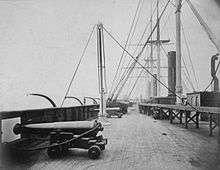
In 1863 Great Eastern made three voyages to New York, with 2,700 passengers being carried out and 970 back to Britain along with a large tonnage of cargo. One of her paddle wheels was damaged on the last outward trip and she completed it using her screw, while on the return journey she ran down and damaged sank Jane, a 775 ton sailing ship, with the loss of two of her 22 crew. It was found that Great Eastern was not maintaining sufficient look-out for the speed she was steaming at; thus she was held to blame for the collision.[24] The company lost nearly £20,000 on the voyages due to a price war between the Cunard and Inman shipping lines, and ended up with debts of more than £142,000, which forced them to lay up Great Eastern.
Sale
A plan was mooted to offer the ship in a lottery, which came to nothing, and the ship was finally offered for sale on 14 January 1864 at the Liverpool Exchange, the bidding opening at £50,000. No bids were offered and the ship was withdrawn from sale, the auctioneer declaring that it would be offered for sale with no reserve in three weeks' time.
Meanwhile, Daniel Gooch approached Thomas Brassey and John Pender to see if they would be willing to assist in the purchase of Great Eastern. The opening bid at the auction was £20,000 and John Yates who was acting for Gooch secured the ship for a bid of £25,000, despite the ship being worth £100,000 in materials alone.
The three men set up a new company, the Great Eastern Steamship Company, and Great Eastern was chartered to the newly formed Telegraph Construction and Maintenance Company for £50,000 of shares, and would be responsible for carrying out the necessary conversion work for the ship's new role, laying the Atlantic Cable.
Cable laying

The conversion work for Great Eastern's new role consisted in the removal of funnel no. 4 and some boilers as well as great parts of the passenger rooms and saloons to give way for open top tanks for taking up the coiled cable. Under Sir James Anderson[25] she laid 4,200 kilometres (2,600 mi) of the 1865 transatlantic telegraph cable. Under Captains Anderson and then Robert Halpin, from 1866 to 1878 the ship laid over 48,000 kilometres (30,000 mi) of submarine telegraph cable including from Brest, France to Saint Pierre and Miquelon in 1869, and from Aden to Bombay in 1869 and 1870.
Break up
.jpg)
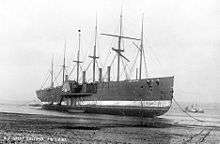
At the end of her cable-laying career she was refitted once again as a liner but once again efforts to make her a commercial success failed. She was used as a showboat, a floating palace/concert hall and gymnasium. She acted as an advertising hoarding—sailing up and down the Mersey for Lewis's Department Store, who at this point were her owners, before being sold.[26][27] The idea was to attract people to the store by using her as a floating visitor attraction. She was sold at auction in 1888, fetching £16,000 for her value as scrap.[28][29]
An early example of breaking-up a structure by use of a wrecking ball, she was scrapped at New Ferry on the River Mersey by Henry Bath & Son Ltd in 1889–1890—it took 18 months to take her apart. At the time Everton Football Club were looking for a flagpole for their Anfield ground, and consequently purchased her top mast. It still stands there today at the ground—now owned by Liverpool Football Club, at the Kop end.[30] In 2011, the Channel 4 programme Time Team found geophysical survey evidence to suggest that residual iron parts from the ship's keel and lower structure still reside in the foreshore.[31]
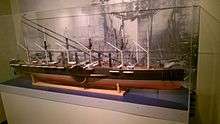
During 1859, when Great Eastern was off Portland conducting trials, an explosion aboard blew off one of the funnels. The funnel was salvaged and subsequently purchased by the water company supplying Weymouth and Melcombe Regis in Dorset, UK, and used as a filtering device. It was later transferred to the Bristol Maritime Museum close to Brunel's SS Great Britain then moved to the SS Great Britain museum.
In popular culture
- The SS Great Eastern is the subject of the Sting song, "Ballad of the Great Eastern" from the 2013 album The Last Ship.
- An Atlantic crossing on the SS Great Eastern is the backdrop to Jules Verne's 1871 novel A Floating City
- The SS Great Eastern and its creator Isambard Kingdom Brunel are central to Howard A. Rodman's 2019 novel The Great Eastern, in which Captain Ahab is pitted against Captain Nemo.
Gallery
 On the deck, 1857
On the deck, 1857 Great Eastern,
Great Eastern,
12 November 1857- SS Great Eastern's launch ramp at Millwall
 Print referring to the difficulty of trying to launch Great Eastern, in the collection of The Mariners' Museum
Print referring to the difficulty of trying to launch Great Eastern, in the collection of The Mariners' Museum Magazine illustration ca. 1877
Magazine illustration ca. 1877- James Henry Pullen's model of SS Great Eastern

 Part of a funnel from the SS Great Eastern. SS Great Britain Museum, Bristol.
Part of a funnel from the SS Great Eastern. SS Great Britain Museum, Bristol.
See also
- James Henry Pullen's model of SS Great Eastern
- SS Great Britain
- SS Great Western
- Steering engine – Great Eastern was the first ship so equipped
- Transatlantic telegraph cable
- List of large sailing vessels
References
- Dawson, Philip S. (2005). The Liner. Chrysalis Books. p. 37. ISBN 978-0-85177-938-6.
- Image:Oscillating engine, and boilers, of Great Eastern - gteast.gif224kB.png
- "Ocean Record Breaking". New York Times. 7 July 1895.
- Wilson, Arthur (1994). The Living Rock: The Story of Metals Since Earliest Times and Their Impact on Civilization. Woodhead Publishing. p. 203. ISBN 978-1-85573-301-5.
- Rolt 1957, p. 309
- Rolt 1957, p. 313
- Gillings, p. 128
- Rolt 1957, p. 313
- Rolt 1957, p. 314
- "Mechanics Monthly - Isambard Kingdom Brunel". ikbrunel.org.uk.
- "Brunel 200: SS Great Eastern". brunel200.com.
- "Great Eastern Launch Site". www.infobritain.co.uk. Archived from the original on 20 September 2015. Retrieved 14 October 2015.
- de Lesseps, Ferdinand (1857). Inquiry into the opinions of the commercial classes of Great Britain on the Suez ship canal. London: John Wheal. pp. 63.
- "Fatal boat accident in the Southampton Docks". The Standard (11058). London. 21 January 1860. p. 5.
- Burke, Edmund (1859). The Annual Register. London: J. & F.H. Rivington. p. 140.
- Buchanan, R. A. (January 1983). "The Great Eastern Controversy: A Comment". Technology and Culture. 24 (1): 98–106. doi:10.2307/3104172. JSTOR 3104172.
- Emmerson, p. 99
- Dugan, p. 52
- Tyler, p. 323
- Annual Report of the American Institute of the City of New York. C. van Benthuysen. 1862. pp. 421–422.
- "The way the Great Eastern was saved," Scientific American, vol. 5, no. 17, pages 263–264 (26 October 1861). Available on-line at: Internet Archive.
- Appletons' annual cyclopaedia and register of important events of the year: 1862. New York: D. Appleton & Company. 1863. p. 501.
- The American Annual Cyclopædia. D. Appleton and Company. 1863. pp. 501–502.
- "Law Intelligence". Bury and Norwich Post (4259). Bury St. Edmunds. 9 February 1864. p. 3.
- "History of the Atlantic Cable & Submarine Telegraphy - Great Eastern". atlantic-cable.com.
- S. R. Hill (4 July 2016). The Distributive System: The Commonwealth and International Library: Social Administration, Training, Economics and Production Division. Elsevier. pp. 101–. ISBN 978-1-4831-3777-3.
- Steven Brindle (23 May 2013). Brunel: The Man Who Built the World. Orion Publishing Group. pp. 121–. ISBN 978-1-78022-648-4.
- Paul Graves-Brown; Rodney Harrison; Angela Piccini (17 October 2013). The Oxford Handbook of the Archaeology of the Contemporary World. OUP Oxford. pp. 250–. ISBN 978-0-19-166395-6.
- David Hall; Fred Dibnah (31 March 2013). Fred Dibnah's Age Of Steam. Ebury Publishing. pp. 89–. ISBN 978-1-4481-4140-1.
- "LIVERWEB - An A to Z of Liverpool FC - G". liverweb.org.uk. Archived from the original on 20 December 2004.CS1 maint: unfit url (link)
- Presenter: Tony Robinson (10 November 2011). "Brunel's Last Launch". Time Team Special. Channel 4.
|access-date=requires|url=(help)
Further reading
- Wallace, William A. (2014). The Great Eastern's Log: Containing Her First Transatlantic Voyage and All Particulars of Her American Visit. Europaischer Hochschulverlag Gmbh & Co. ISBN 978-3954272662.
- Tyler, David Budlong (1939). Steam Conquers the Atlantic. D. Appleton-Century.
- Emmerson, George S. (1981). S.S. Great Eastern. David & Charles. ISBN 978-0-7153-8054-3.
- Gillings, Annabel (2006). Brunel. Haus Publishing. ISBN 978-1-904950-44-8.
- Dugan, James (1953). The Great Iron Ship. Harper. ISBN 978-0-7509-3447-3.
- Rolt, L. T. C. (1957). Isambard Kingdom Brunel. Longmans.CS1 maint: ref=harv (link)
- Verne, Jules (1871). A Floating City. Harper. ISBN 978-0-7509-3447-3. (account of his 1867 voyage on the Great Eastern)
- Cadbury, Deborah (2003). Seven Wonders of the Industrial World. Fourth Estate. ISBN 978-0-00-716304-5.
- The Titanic Disaster: An Enduring Example of Money Management vs. Risk Management
- Edited by Andrew Kelly and Melanie Kelly, Brunel – In Love With the Impossible, 2006 by Bristol Cultural Development Partnership, Hardback ISBN 0-9550742-0-7, Paperback ISBN 0-9550742-1-5
External links
| Wikimedia Commons has media related to SS Great Eastern. |
| Wikisource has the text of the 1920 Encyclopedia Americana article Great Eastern. |
- Great Eastern on thegreatoceanliners.com
- The building of the Great Eastern. at Southern Millwall: Drunken Dock and the Land of Promise, pp. 466–480, Survey of London volumes 43 and 44, edited by Hermione Hobhouse, 1994.
- The Great Eastern and Cable Laying
- Brief description of the Great Eastern
- Great Eastern timeline
- SS Great Eastern on Facebook
- First voyage of the Great Eastern, in The Engineer, 16 September 1859.
- Images of the Great Eastern at the English Heritage Archive
- Maritimequest SS Great Eastern Photo Gallery